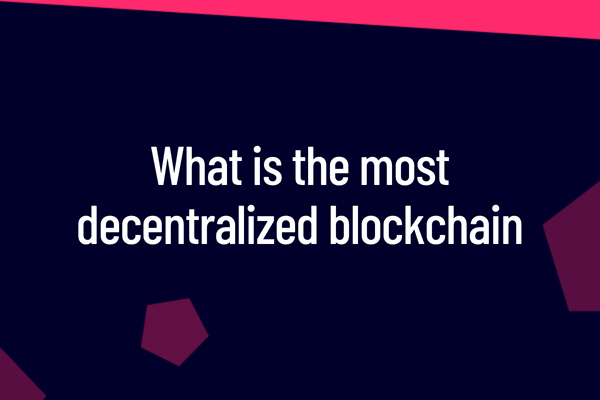What is decentralization?
When talking about blockchain, decentralization often refers to some kind of control that is transferred from a centralized body, like an organization, an individual, or a group. Decentralized networks go all out to reduce the level of trust that members have to place in one another and discourage their ability to employ authority or control over each other in ways that severely degrade the efficiency of the network.
Decentralization is not a new concept, and to be real it’s important. When creating a technology solution there are usually three primary network architectures considered. Centralized, distributed, and decentralized. Even though blockchain technologies often make use of decentralized networks, a blockchain application can’t be simply labeled as decentralized or centralized.
Decentralization is like a sliding scale and should be spread to all aspects of a blockchain. More outstanding and fairer service can be achieved by decentralizing the management and accessing resources in the application. Typically, decentralization has some tradeoffs like lower transaction throughput, but in a perfect sense, the tradeoffs are worth the stability and service that they produce. Decentralization should always depend on the needs of users. If an application is a blockchain, that doesn’t mean it has to be 100% decentralized. Any blockchain solution aims to give its users what they need from the service, and this might or might not entail decentralization to some degree.
Decentralized blockchain systems prioritize security while distributed systems focus on performance. However, when a decentralized network increases in size or extent, it becomes more secure but also slower because each node must validate the data being recorded. Therefore, adding members to make a stronger system does not equate to making it faster.
The various blockchain protocols, decentralized Applications (dApp), Decentralized Autonomous Organizations (DAO), or other blockchain-related solutions typically adopt decentralization to different degrees. The amount they centralize is usually based on how effective and trustworthy the solution’s incentive models and consensus mechanisms are in combination with the level of experience of the founding team.
Networks
The term “decentralization” is often used when discussing cryptocurrencies and blockchains. Some believe that this word signifies a system or structure without any central authority, while others believe it means the power and control of a network are distributed evenly among those using it.
Let’s look at the US dollar and Bitcoin as examples to understand decentralization. The government of the United States has complete control over the US dollar and can print new bills whenever it wants to. They also have power over how banks distribute them and access worldwide monitoring tools. As a result, the US dollar is a monopolized currency.
Since no individual can create or distribute new Bitcoin tokens, the decentralized Bitcoin network is controlled by a mechanism called consensus, which involves various entities or nodes. Even though decentralization is mostly theoretical at this point, scalability and security always require some level of centralization.
Although Bitcoin has been successful, there are limitations to its scalability. For example, because of the decentralized nature of a blockchain, it is theoretically one of the most decentralized blockchains ever created. It was designed so that anybody can use a computer to join the network’s consensus mechanism, mine bitcoin, and take part in the voting process. This was an excellent illustration of what a genuinely decentralized network should look like.
However, as the mining difficulty rose due to an increase in new miners, high-end systems were required to mine new blocks. Only a few had the financial means to acquire such systems and operate them, which they had to do at a considerable cost. As a result, certain mining collectives seized control of the mining market.
These few big mining pools have more influence on the network than typical consumers. Many blockchains have encountered similar issues. However, a small number of blockchains has kept high levels of decentralization owing to innovative technologies and mining techniques.
Bitcoin
Bitcoin is the first and most well-known cryptocurrency. Its creator’s identity, Satoshi Nakamoto, is still unknown today. Bitcoin is often praised for its decentralization; according to “bitnodes.io”, there are 15,092 active nodes in the network.
Although Bitcoin is a global network, only a few developers are responsible for its maintenance. Additionally, most of the specialized hardware and equipment needed to keep the network running smoothly is located in either the United States or Germany. Furthermore, Bitcoin’s proof-of-work (PoW) system requires ongoing electricity costs to keep it functioning properly.
Although Bitcoin was designed to let anybody in the world who has a laptop can become a miner, competition and the size of the Bitcoin blockchain mean that only people with expensive computers can mine for bitcoin. Furthermore, independent miners are often unprofitable.
Bitcoin mining is expensive and difficult, so only those who can afford it can participate. This means that a small number of industrial miners have a lot of control over the Bitcoin network. However, the theory says that as new miners join, the network becomes more decentralized.
Ethereum
Ethereum is the prominent smart contract blockchain and has the second-largest market capitalization after Bitcoin. Even though it has a smaller number of nodes in its network when compared to Bitcoin, Ethereum has one of the most significant development communities globally. Therefore, Ethereum could be more decentralized than Bitcoin because more individuals have a say in where the network will go next.
Though Ethereum has a central figure in co-founder Vitalik Buterin, it still falls prey to the same issues of monopolization that Bitcoin does. US concentration of hash power is around 40% for Ethereum, which is more than double that of its competitors. Additionally, the PoW consensus mechanism makes it just as susceptible to being run by a single entity.
Even though Ethereum is moving to a proof-of-stake (PoS) consensus mechanism, which doesn’t require mining equipment or pools, and has the potential to decentralize much more. Lowering the barrier to entry for validators, this move increases the likelihood of success for PoS.
By staking 32 ETH, validators can participate in Ethereum’s PoS consensus mechanism rather than electric-hungry and costly machines. This shift is a move towards a more equal and sustainable future for the Ethereum network.
Importance of decentralization
Decentralization is important to some people while others may prioritize things like high throughput or low transaction fees. Additionally, the recent increase in layer-2 scaling solutions suggests that blockchain and cryptocurrency adoption could rely more on performance than decentralization. The Bitcoin network is a trade-off many believers of sound money can live with, though the five or so transactions per second (TPS) it can process is quite low in comparison to other networks.
Bitcoin transactions usually process within a few minutes, which is an acceptable amount of time to wait for individuals and businesses who want to gain financial freedom and avoid the debasement of fiat currencies. Also, blockchain skills are highly in demand across most industries.
Although most cryptocurrencies strive to be decentralized, we have discovered that over time, almost every cryptocurrency experiences some form of centralization. Some people believe this to be critical for the success of a blockchain network.
However, many people believe that centralization is a danger to public blockchains and cryptocurrencies. If any individual or group owns the majority of a certain crypto asset, they have the power to control its price.
In addition, when there is too much hash power concentrated in one place, it can make crypto mining unprofitable for most people. Finally, centralization creates a single point of failure that makes databases and computing networks vulnerable to attack.
Related Posts





